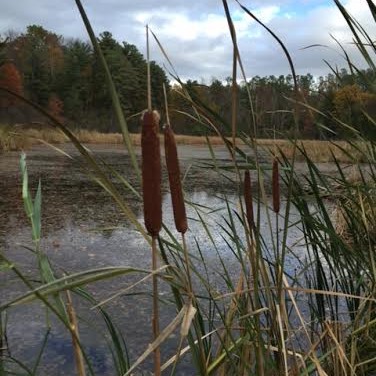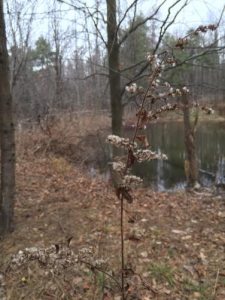While I was home over Thanksgiving, I looked for a Phenology spot that was similar to my spot in Burlington. I decided to use one of the lovely ponds in my backyard. Like my Burlington spot, my home pond is almost entirely surrounded by trees and undergrowth. Both ponds are home to a wide variety of fish, amphibian, bird, and plant life, with many chickadees this time of year. Both ponds are surrounded by a mix of coniferous and deciduous trees, with Goldenrod patches intermingled with them.
to use one of the lovely ponds in my backyard. Like my Burlington spot, my home pond is almost entirely surrounded by trees and undergrowth. Both ponds are home to a wide variety of fish, amphibian, bird, and plant life, with many chickadees this time of year. Both ponds are surrounded by a mix of coniferous and deciduous trees, with Goldenrod patches intermingled with them.
As similar as these spots are, there are many differences I noted at I studied my home pond. One major difference is the lack of Cattails at my home spot. In Burlington, the Cattails are a integral part of the ecosystem, and make up a micro-ecosystem of their own. They provide a breeding habitat for many birds such as Marsh Wrens, Red-Winged Blackbirds, Swamp Sparrows, American Bitterns, Least Bitterns, Common Moorhens, Pied-Billed Grebes, Virginia Rails, Soras, Black Terns, Mallards, Black Ducks, and Blue-Winged Teals. Cattails are used as a hunting ground for Great Blue Herons and Black-Crowned Night Herons. Amphibians that are common to Cattail ecosystems include Bullfrogs, Leopard Frogs, Green Frogs, and Gray Treefrogs. Painted and Snapping turtles, Muskrats, and Northern water snakes are also common (Thompson). Although Mallards and Great Blue Herons occasionally visit the pond near my house, they do not nest or stay for long periods of time due to the lack of Cattails. Painted turtles and Bullfrogs live in the pond, but in very low numbers. The diversity of this pond would be greatly increased by the presence of Cattails.
The vegetation is also slightly different. My Burlington Phenology spot has a lot of Buckthorn and Boxelder, neither of which are present at my home Phenology spot. My home Phenology spot contains a lot more Honeysuckle than my Burlington spot, and has different tree species. The species of my home spot include American Beech, Red Pine, Black Cherry, Green Ash, and Big-Tooth Aspen, in contrast to Buckthorn, Basswood, and Northern Red Oak.
Another huge difference is the overall layout, location and size of the phenology spots. The Burlington spot is located right on the waterfront, putting it in close contact with a lot of humans, thus increasing litter and pollution and animals that reside along lakes, such as gulls. The Burlington spot has very different vegetation and is a lot larger, making it home to different populations of animals than my home spot, along with a wider diversity and magnitude of life. Although my home spot has less human contact, and therefore receives less pollution in the form of litter, it backs up a muddy slope in a horse pen so receives pollution in the form of nitrates and phosphates from the manure, and lots of mud which fills in the pond. The Burlington spot’s soil is a lot sandier, due to its location on the beach, whereas the soil of my home spot contains a lot of clay. The sandy soil in Burlington results in species that like well-drained yet moist soil, such as Northern Red Oaks, which do not like the clay-filled soils near my home spot. The two spots are also located in very different areas, one being in Vermont and the other being in the Buffalo, New York region. Both spots are equally special and beautiful, and provide a lot for the natural community and humans alike.

